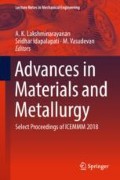Abstract
The disposal of used automobiles tyres is a major environmental concern of the day. Annually, there are 1.2 billion tyres seeking disposal issues globally. Concrete as a major construction material can potentially adopt processed rubber waste—derived from tyres as a partial replacement for aggregates. The present study is focused on mechanical and thermal properties of concretes with rubber as partial replacement to well-graded conventional aggregates. The study includes replacement of 10, 20, 30 and 100% of coarse aggregate with waste tyre aggregates and was compared with conventional M30 grade concrete. Concretes were subjected a thermal cyclic heating of 50 °C for a period of 7 days. The results showed that the weight of the rubber concrete is reduced by 12% compared to the conventional concrete and the strength of the concrete reduces with the increase in rubber content. At ambient temperatures, the rubber concrete was found thermally stable. The compressive strengths were found increasing after cyclic heating of 50 °C for a period of 7 days. This effect may be due the effect of Portland pozzolana cement which has 30% of fly ash in it. From this study, it can be concluded that rubber waste concretes can be a potential candidate for structural and non-load bearing structures at ambient temperatures.
Access this chapter
Tax calculation will be finalised at checkout
Purchases are for personal use only
References
Eldin NN, Senouci AB (1993) Rubber-tire practices as concrete aggregate. J Mater Civ Eng 5(4):478–496
Schimizze RR, Nelson JK, Amirkhanian SN, Murden JA (1994) Use of waste rubber in light-duty concrete pavements. In: Proceedings of the third material engineering conference, infrastructure: new materials and methods of repair. San Diego, CA, pp 367–374
El-Gammal A, Abdel-Gawad AK, El-Sherbini Y, Shalaby A (2010) Compressive strength of concrete utilizing waste tire rubber. J Emerg Trends Eng Appl Sci 1(1):96–99
Kotresh KM, Belachew MG (2014) Study on waste tyre rubber as concrete aggregates. Int J Sci Eng Technol 3(4):433–436
Torgal FP, Shasavandi A, Jalali S (2011) Tyre rubber wastes based concrete: a review. In: Wastes: solutions, treatments and opportunities. 1st international conference. Guimarães, Portugal
Topcu JB (1995) The properties of rubberized concretes. Cem Concr Res 25(2):304–310
Khatib ZK, Bayomy FM (1999) Rubberized portland cement concrete. J Mater Civ Eng 11(3):206–213
Zheng L, Huo XS, Yuan Y (2008) Strength, modulus of elasticity, and brittleness index of rubberized concrete. J Mater Civ Eng 20:692–699
Barla MA, Eleazer WE, Whittle DJ (1993) Potential to use waste tires as supplemental fuel in pulp and paper mill boilers, cement kilns and in road pavement. Waste Manage Res 11(6):463–480
Collins KJ, Jensen AC, Mallinson JJ, Mudge SM, Russel A, Smith lP (2001) Scrap tyres for marine construction: environmental impact. In: Dhir RK, Limbachiyya MC, Paine KA (eds) Recycling and reuse of used tyres. Thomas Telford, London, pp 149–162
Wójtowicz MA, Bassilakis R, Serio MA (2004) Carbon black derived from waste tire pyrolysis oil. Advanced Fuel Research, Inc
Seckinger NR, Abu-Odeh A, Bligh RP, Roschke PN (2005) Performance of guardrail systems encased in pavement mow strips. J Transp Eng 131(11):851–860
Lakušić S, Bjegović D, Haladin I, Baričević A, Serdar M (2011) RUCONBAR—innovative noise protection solution made of recycled waste tyre. Mech Transp Commun 3:X-76–X-82
Xiao F, Amirkhanian SN, Shen J, Putman B (2009) Influences of crumb rubber size and type on reclaimed asphalt pavement (RAP) mixtures. Constr Build Mater 23(2):1028–1034
IS 7320 (1974) Specification for concrete slump test apparatus. Bureau of Indian Standards, New Delhi
IS 5512 (1983) Specification for flow table for use in tests-of hydraulic cements and pozzolanic materials. Bureau of Indian Standards, New Delhi
IS 383 (2016) Coarse and fine aggregate for concrete specification(third revision). Bureau of Indian Standards, New Delhi
Poon CS, Azhar S, Anson M, Wong YL (2001) Comparison of the strength and durability performance of normal- and high-strength pozzolanic concretes at elevated temperatures. Cem Concr Res 31:1291–1300
Haneefa KM, Santhanam M, Parida FC (2013) Review of concrete performance at elevated temperature and hot sodium exposure applications in nuclear industry. Nucl Eng Des 258:76–88
Haneefa KM, Santhanam M, Parida FC (2013) Thermal performance of limestone mortars for use in sodium cooled fast breeder reactors. Indian Concr J 87(12):25–41
Hossain KMA (2006) High strength blended cement concrete incorporating volcanic ash: Performance at high temperatures. Cem Concr Compos 28:535–545
Nasser KW, Marzouk HM (1979) Properties of mass concrete containing fly ash at high temperatures. ACI J 76(4):537–551
IS 5515 (1983) Specification compacting factor apparatus. Bureau of Indian Standards, New Delhi
Acknowledgements
The authors acknowledge the contributions of Mr. K. Hutesh Reddy, Mr. K. Madhan Gopal, and Mr. Tammineni Sai Krishna Undergraduate students in Department of Civil Engineering, SSN College of Engineering for this project. The authors are grateful to SSN Trust for their financial support through student internal funding from student project scheme.
Author information
Authors and Affiliations
Corresponding author
Editor information
Editors and Affiliations
Rights and permissions
Copyright information
© 2019 Springer Nature Singapore Pte Ltd.
About this paper
Cite this paper
Rajagopalan, S., Sreehari, P., Mahalingam, B., Haneefa, K.M. (2019). On Mechanical and Thermal Properties of Concretes with Rubber as Partial Replacement to Well-Graded Conventional Aggregates. In: Lakshminarayanan, A., Idapalapati, S., Vasudevan, M. (eds) Advances in Materials and Metallurgy. Lecture Notes in Mechanical Engineering. Springer, Singapore. https://doi.org/10.1007/978-981-13-1780-4_7
Download citation
DOI: https://doi.org/10.1007/978-981-13-1780-4_7
Published:
Publisher Name: Springer, Singapore
Print ISBN: 978-981-13-1779-8
Online ISBN: 978-981-13-1780-4
eBook Packages: EngineeringEngineering (R0)

